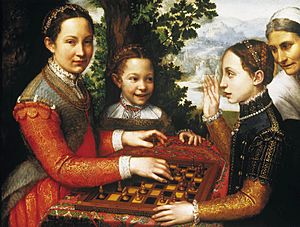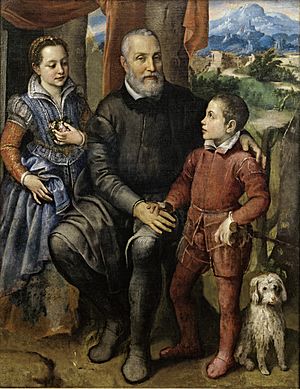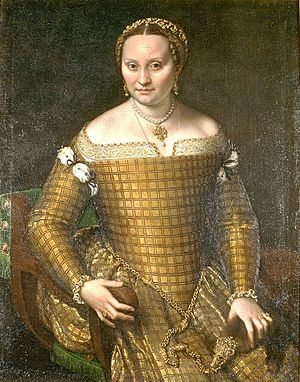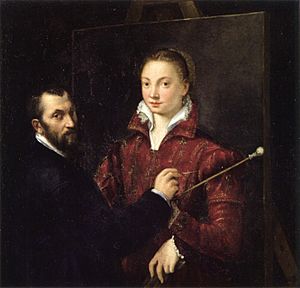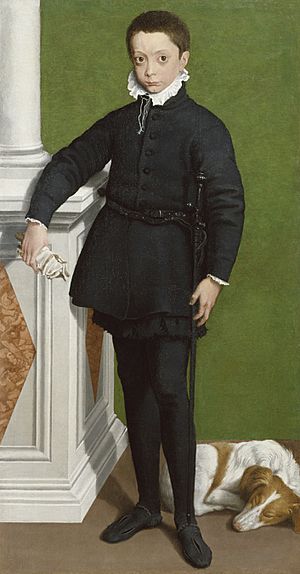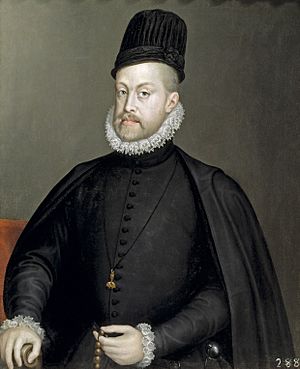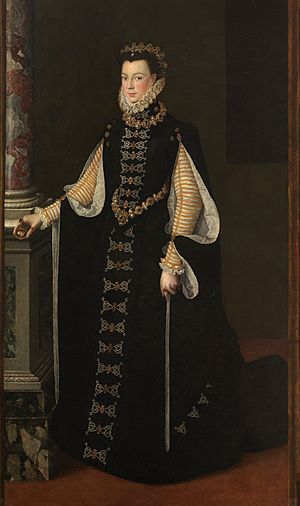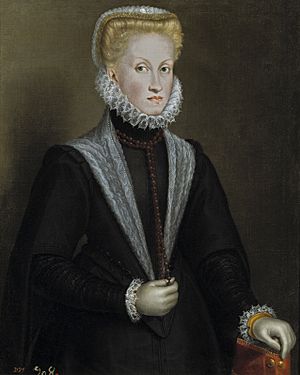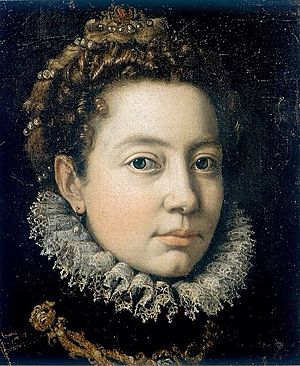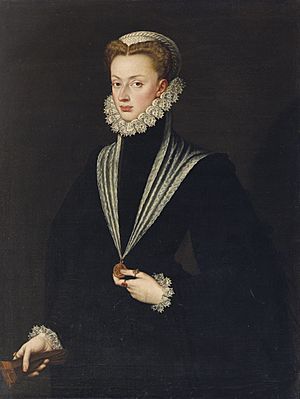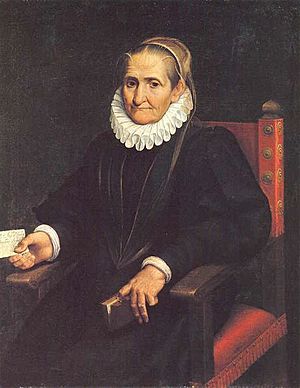Sofonisba Anguissola facts for kids
Quick facts for kids
Sofonisba Anguissola
|
|
|---|---|
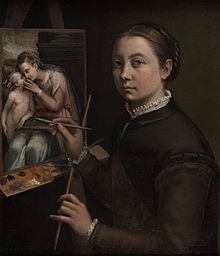
Self-Portrait, 1556, Lancut Museum, Poland
|
|
| Born | c. 1532 |
| Died | 16 November 1625 (aged 93) |
| Nationality | Italian |
| Education | Bernardino Campi, Bernardino Gatti |
| Known for | Portrait painting, drawing |
| Movement | Late Renaissance |
| Patron(s) | Philip II of Spain |
Sofonisba Anguissola (around 1532 – 16 November 1625) was an amazing Italian Renaissance painter. She was born in Cremona, Italy, into a noble family that wasn't very rich. Sofonisba got a great education, including learning about fine arts. Her training with local painters was special because it helped other women become art students too.
When she was young, Anguissola traveled to Rome. There, she met the famous artist Michelangelo, who quickly saw how talented she was. She also visited Milan, where she painted the important Duke of Alba. In 1559, the Spanish queen, Elizabeth of Valois, who loved to paint, asked Sofonisba to come to Madrid. Sofonisba became her art teacher and a lady-in-waiting. She later became an official painter for King Philip II. She changed her painting style to fit the formal look needed for royal portraits.
After the queen passed away, King Philip helped Sofonisba arrange a noble marriage. She moved to Sicily, then to Pisa and Genoa. She kept working as a top portrait painter for many years.
Sofonisba's best paintings are her portraits of herself and her family. She painted these before she moved to Spain. Her pictures of children were especially fresh and showed great detail. At the Spanish court, she painted formal royal portraits. She was one of the first and most successful female court painters. Later in her life, she also painted religious scenes, but many of these are now lost. She passed away in Palermo in 1625, at 93 years old.
Sofonisba Anguissola's success helped many other women become serious artists. Her paintings are now in museums around the world. You can see them in Boston, Milwaukee, Madrid (Museo del Prado), and Florence (Uffizi Gallery).
Her friend Giorgio Vasari, who was also an artist, wrote that Anguissola was better at drawing and painting than any other woman of her time. He said she could paint from real life and create beautiful new paintings.
Contents
- Sofonisba Anguissola's Family History
- Sofonisba's Early Life and Art Training
- Life as a Female Artist
- Working at the Spanish Royal Court
- Sofonisba's Personal Life
- Later Years and Legacy
- Sofonisba Anguissola's Artistic Style
- Why Sofonisba Anguissola is Important
- A Crater Named After Her
- Recent Art Shows
- See also
- Novels About Her Life
Sofonisba Anguissola's Family History
The Anguissola family was very old and noble. Their name comes from a story from the Byzantine Empire.
The story says that in 717, a brave soldier named Galvano Sordo helped save the city of Constantinople. He used a special weapon called Greek fire. This fire helped defeat the enemies who were attacking the city.
Galvano's family shield had a picture of a snake (anguis in Latin). After his victory, people cheered, "Anguis sola fecit victoriam!" This means "The snake alone brought the victory!" Galvano was nicknamed "Anguissola," and his family took this name. Some people think Sofonisba's small self-portrait has a secret message about this family motto.
Later, the Anguissola family moved to Italy to escape a terrible sickness. They married into other important families and built homes in cities like Piacenza and Cremona.
Sofonisba's Early Life and Art Training
Sofonisba Anguissola was born in 1532 in Cremona, Italy. She was the oldest of seven children, and six of them were girls! Her father, Amilcare Anguissola, and her mother, Bianca Ponzone, were both from noble families.
Her father named his children after famous ancient figures. Sofonisba was named after a brave queen from Ancient Carthage. Her brother, Asdrubale, was named after a Carthaginian general. Amilcare Anguissola wanted all his daughters to develop their talents.
Four of Sofonisba's sisters also became painters: Elena, Lucia, Europa, and Anna Maria. Sofonisba was the most famous and taught her younger sisters. Elena later became a nun. Anna Maria and Europa stopped painting when they got married. Lucia was also a very good painter but died young. Their other sister, Minerva, became a writer.
Sofonisba's father made sure she and her sisters got a good education, including art. When Sofonisba was 14, she and Elena went to study with Bernardino Campi. He was a respected portrait painter. When Campi moved, Sofonisba continued her studies with Bernardino Gatti. Sofonisba's art training helped open doors for other women to study art. She studied with Gatti for about three years.
One of her first important paintings was Bernardino Campi Painting Sofonisba Anguissola (around 1550). This painting shows her teacher painting her portrait.
In 1554, when she was 22, Sofonisba traveled to Rome. She spent her time sketching people and scenes. In Rome, she met Michelangelo. Sofonisba showed him a drawing of a laughing girl. Michelangelo then challenged her to draw a crying boy, which he thought would be harder. Sofonisba drew Boy Bitten by a Crayfish and sent it to him. Michelangelo immediately saw her amazing talent. He even gave her his own sketches to copy in her style and offered her advice. Sofonisba learned a lot from Michelangelo for at least two years.
Life as a Female Artist
Being a female artist in Sofonisba's time was different from being a male artist. Women usually couldn't study anatomy or draw nude models. This meant they couldn't create the large, complex paintings needed for big religious or historical scenes.
Instead, Sofonisba tried new ways of painting portraits. She often painted people in informal, everyday settings. Her most common subjects were herself and her family. Some examples include Self-Portrait (1554) and The Chess Game (1555). The Chess Game shows her sisters Lucia, Minerva, and Europa playing chess. It's a close-up of a family scene, showing fancy clothes with relaxed faces. This was very new for Italian art at the time. This painting is like a "conversation piece," showing a group of people doing an activity together.
Sofonisba's self-portraits also show her ideas about being a woman artist. In her 1556 self-portrait, she shows herself as the artist, not just someone being painted. Other paintings show her playing a musical instrument, taking on a different role. Later, she painted herself as both an artist and a wife.
Sofonisba became famous outside Italy. In 1559, King Philip II of Spain asked her to be a lady-in-waiting and art teacher for his young wife, Queen Elisabeth of Valois. Elisabeth was only 14 at the time. Queen Elisabeth and Sofonisba became good friends. Sofonisba painted the whole royal family. Even the Pope asked her to paint a portrait of the Queen.
Working at the Spanish Royal Court
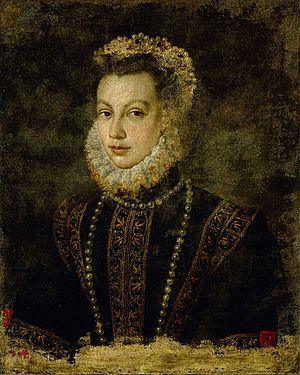
In 1558, Sofonisba was already a well-known painter. She went to Milan and painted the Duke of Alba. He then told King Philip II about her. The next year, Sofonisba was invited to join the Spanish Royal Court. This was a huge moment in her career.
Sofonisba was about 26 when she left Italy for Spain. She arrived in Madrid in late 1559 or early 1560. She worked as a court painter and lady-in-waiting for the new queen, Elisabeth of Valois. Elisabeth was Philip's third wife and enjoyed painting herself. Sofonisba quickly became the queen's trusted friend. She spent years painting many official portraits for the court, including Philip II's sister, Joanna, and his son, Don Carlos.
These royal portraits were much harder than her earlier informal ones. They needed a lot of time and effort to show the detailed designs of the royal clothes and jewelry. But Sofonisba's paintings of Queen Elisabeth and later of Anne of Austria (Philip II's fourth wife) were lively and full of spirit.
During her 14 years at court, she helped Queen Elisabeth with her art. She also influenced the art of the king's two daughters. Sofonisba painted a portrait for Pope Pius IV in 1561. After Queen Elisabeth died in 1568, Sofonisba painted Anne of Austria. She earned a good salary and gifts, which made her quite wealthy.
While working for Queen Elisabeth, Sofonisba also worked closely with Alonso Sanchez Coello. They worked so closely that a famous painting of King Philip II was thought to be by Coello for a long time. Only recently was Sofonisba recognized as the true artist of that painting.
Sofonisba's Personal Life
After Queen Elisabeth of Valois died in 1568, King Philip II took a special interest in Sofonisba's future. He wanted her to marry a Spanish nobleman. In 1571, when she was almost 40, Sofonisba had an arranged marriage to a nobleman from Sicily. King Philip II even paid a large dowry for her marriage to Fabrizio Moncada Pignatelli. Fabrizio was said to support her painting. Sofonisba and her husband left Spain and lived in Sicily for several years. She received money from the king, which allowed her to keep painting and teaching other artists.
Sofonisba's husband passed away in 1579. Two years later, while traveling by sea, she met and fell in love with the ship's captain, Orazio Lomellino. They married in 1584 and lived in Genoa until 1620. She didn't have any children of her own, but she stayed close with her nieces and her stepson.
Later Years and Legacy
Lomellino was wealthy, and Sofonisba also received a generous pension from King Philip II. This meant she could paint freely and live very comfortably. She was quite famous by then, and many other artists came to visit her. Younger artists were eager to learn from her unique style.
In her later life, Sofonisba painted religious scenes again, like she did when she was young. Many of these paintings are now lost. She was the most important portrait painter in Genoa until she moved to Palermo in her final years. In 1620, she painted her last self-portrait.
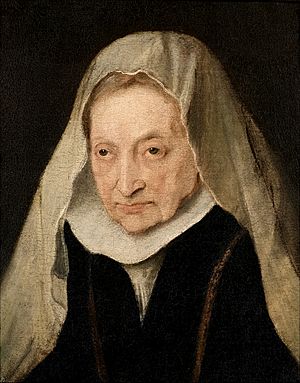
On July 12, 1624, a young Flemish painter named Anthony van Dyck visited Sofonisba. He wrote notes about his visit in his sketchbook. Van Dyck thought she was 96 (she was actually about 92). He noted that even though her eyesight was weak, Sofonisba was still very sharp mentally. He wrote down the advice she gave him about painting. Van Dyck said their talk taught him more about painting than anything else in his life. He drew her portrait during his visit. This last portrait of Sofonisba can be seen at Knole. The next year, she returned to Sicily.
Sofonisba became a generous supporter of the arts as her eyesight got weaker. She passed away in Palermo in 1625, at the age of 93.
Her second husband, Orazio Lomellino, loved her very much. He described her as small but "great among mortals." He buried her with honor in Palermo.
Sofonisba Anguissola's Artistic Style
You can see the influence of her teacher, Campi, in Sofonisba's early works. Her paintings were delicate and charming. From her other teacher, Gatti, she learned elements that reminded people of the artist Correggio.
Most of Sofonisba's early work includes self-portraits and portraits of her family. Many people think these are her best paintings. She became so famous that many people asked her for portraits of herself.
About 50 paintings are believed to be by Sofonisba Anguissola. Her art is in museums in many cities, including Baltimore, Berlin, Madrid, Milan, and Vienna.
Why Sofonisba Anguissola is Important
Sofonisba Anguissola's art had a lasting impact on artists who came after her. Her portrait of Queen Elisabeth of Valois was copied by many famous artists, like Peter Paul Rubens. Some even think that Caravaggio was inspired by Sofonisba's work for his painting Boy Bitten by a Lizard.
Sofonisba is very important to art historians who study women in art. Even though women always had some role in art, Sofonisba's great success made it easier for more women to become serious artists. Other female painters, like Lavinia Fontana, said they were inspired to learn painting after seeing Sofonisba's portraits. Some of her well-known successors include Lavinia Fontana and Artemisia Gentileschi.
There's even a school in Cremona named after her: Liceo Statale Sofonisba Anguissola.
An American artist named Charles Willson Peale (1741–1827) named his daughter Sophonisba Angusciola after her. This daughter also became a painter.
A Crater Named After Her
On August 4, 2017, a crater on the planet Mercury was named after Sofonisba Anguissola.
Recent Art Shows
- 2019-2020: Sofonisba Anguissola and Lavinia Fontana were the main focus of a big art show called “A Tale of Two Women Painters” at the Museo del Prado in Madrid.
See also
 In Spanish: Sofonisba Anguissola para niños
In Spanish: Sofonisba Anguissola para niños
- Maria Kusche
Novels About Her Life
- Boullosa, Carmen. La virgen y el violín (The Virgin and the Violin). A novel about Sofonisba Anguissola's life.
- DiGiuseppe, Donna. 2019. Lady in Ermine — The Story of a Woman Who Painted The Renaissance: A Biographical Novel of Sofonisba Anguissola.
- Pierini, Giovanna. 2018. La dama con il ventaglio (The Lady with the Fan).
- Montani, Chiara. Sofonisba. I ritratti dell'anima (Sofonisba. The Portraits of the Soul).
- Vihos, Lisa. 2022. The Lone Snake: The Story of Sofonisba Anguissola.


